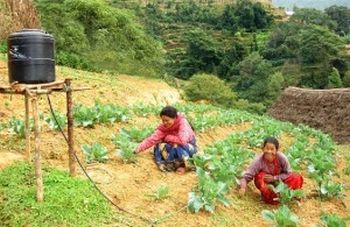
Publisher:
Bonnie King
CONTACT:
Newsroom@Salem-news.com
Advertising:
Adsales@Salem-news.com

~Truth~
~Justice~
~Peace~
TJP
Jul-13-2010 05:50

 TweetFollow @OregonNews
TweetFollow @OregonNews
Innovation of the Week: Slow and Steady Irrigation Wins the Race
Molly Theobald for Salem-News.comSince installing her own drip kit, Elizabeth has seen her income rise to between Z$1 million (US$10) and Z$4 million (US$40) per week.
 Drip irrigation system in Nepal. (Photo credit: IDE) |
(ZIMBABWE) - After Elizabeth Samhembere’s husband passed away in 2004, she struggled to feed her family. A small-scale farmer in Zimbabwe, Elizabeth had trouble getting water to her crops, and her children were too young to help with the labor-intensive task of irrigating the vegetables and strawberries she grew.
“I was making a paltry Z$80,000 (US$0.81) per week from selling small and miserable-looking strawberries, and that did not improve my livelihood,” Elizabeth explained in an interview for International Development Enterprises (IDE). “I continued living from hand to mouth.”
But Elizabeth’s crop—and income—improved significantly in 2005, when she received a donated drip kit, seed, and fertilizer through the Micro Irrigation Partnerships for Vulnerable Households project (MIPVH) of IDE, an organization working to alleviate poverty and hunger in Asia and Africa through technology and market access for small farmers.
Drip irrigation delivers water and fertilizer directly to the roots of plants through systems of plastic tubing with small holes and other restrictive outlets. By distributing these inputs slowly and regularly, drip irrigation conserves up to 50 percent more water than traditional methods, IDE estimates. The water and fertilizer are also more easily absorbed by the soil and plants, reducing the risks of erosion and nutrient depletion. Usually operated by gravity, drip irrigation saves both the time and labor that would otherwise be needed to water crops, leading to larger harvest yields.
Since installing her own drip kit, Elizabeth has seen her income rise to between Z$1 million (US$10) and Z$4 million (US$40) per week. Both the quality and quantity of her strawberry harvest have improved, and she was able to expand her crop diversity by adding peas, carrots, and tomatoes to her garden. With training from the Zimbabwe Women’s Bureau, Elizabeth is also generating income by selling jam she makes from her strawberries.
Elizabeth’s family is eating better, both from the garden and because of the profit she makes from selling her produce. And she no longer worries about going into debt or needing to borrow money to make ends meet. “I am able to send my children to school with the income I now generate from the garden,” she said.
To learn about other ways that irrigation technologies are helping small-scale farmers improve their incomes and livelihoods, see Getting Water to Crops and Access to Water Improves Quality of Life for Women and Children.
Source: Worldwatch Institute
Articles for July 12, 2010 | Articles for July 13, 2010 | Articles for July 14, 2010

Quick Links
DINING
Willamette UniversityGoudy Commons Cafe
Dine on the Queen
Willamette Queen Sternwheeler
MUST SEE SALEM
Oregon Capitol ToursCapitol History Gateway
Willamette River Ride
Willamette Queen Sternwheeler
Historic Home Tours:
Deepwood Museum
The Bush House
Gaiety Hollow Garden
AUCTIONS - APPRAISALS
Auction Masters & AppraisalsCONSTRUCTION SERVICES
Roofing and ContractingSheridan, Ore.
ONLINE SHOPPING
Special Occasion DressesAdvertise with Salem-News
Contact:AdSales@Salem-News.com

Salem-News.com:
googlec507860f6901db00.html

Terms of Service | Privacy Policy
All comments and messages are approved by people and self promotional links or unacceptable comments are denied.
Josh Akers July 13, 2010 11:08 am (Pacific time)
Thanks for the coverage of Africa. Period. Water irrigation technology is as essential as a toilet for Americans.
[Return to Top]©2025 Salem-News.com. All opinions expressed in this article are those of the author and do not necessarily reflect those of Salem-News.com.